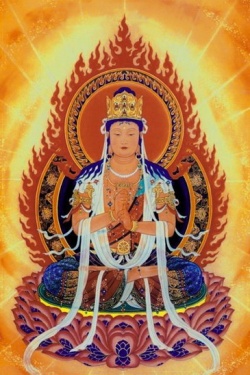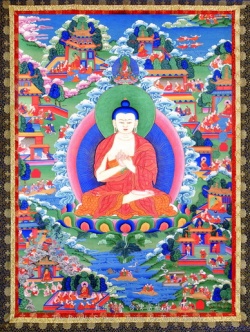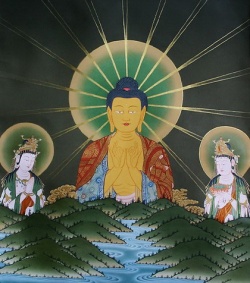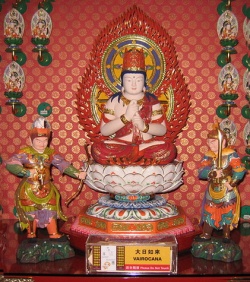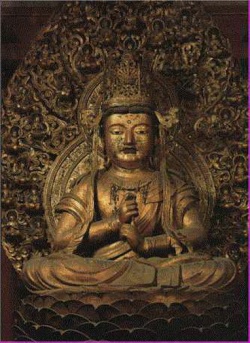Mahavairochana
Mahavairochana
大日如来 (Skt; Jpn Dainichi-nyorai)
The Thus Come One Mahavairochana. A Buddha worshiped in Esoteric Buddhism. The Sanskrit name Mahavairochana is a compound of maha, meaning great, and vairochana, meaning that which is of, related to, or luminous like the sun. It is translated in Chinese Buddhist scriptures as "Great Sun." This Buddha appears in the Mahavairochana Sutra and the Diamond Crown Sutra. He is regarded as the Buddha of the Dharma body who personifies the unchanging truth of all phenomena and is the source from which all Buddhas and bodhisattvas spring. Esoteric Buddhism holds that Maha-Vairochana is always expounding the teaching, and that common mortals can become one with this Buddha through the practice of the three mysteries—the forming of mudras with the hands, the recitation of mantras (magical formulas), and meditation on an esoteric mandala or one of the figures appearing in it. Mahavairochana has two aspects, the Mahavairochana of the Womb Realm, who represents the fundamental truth of the universe, and the Mahavairochana of the Diamond Realm, who represents wisdom. These two are fundamentally one. In Japan, Tendai Esotericism and True Word (Shingon) Esotericism differ in their interpretations of Mahavairochana. The former holds that Mahavairochana is the Buddha of the Dharma body, and that Shakyamuni is the Buddha of the manifested body, or a temporary manifestation of the Buddha of the Dharma body. The latter maintains that they are two entirely distinct and separate Buddhas.
Mahavairocana Buddha (Japanese Dainichi Nyorai) is the fundamental diety of Shingon Buddhism. He is seen as the ultimate reality, the life force that is the origin of everything and that illuminates all. His name means "Great Shining Buddha." According to Shingon, each of us has a Buddha nature and that nature is part of the ultimate reality that is Mahavairocana.
Because Mahavairocana has a dual nature, one part embodying Wisdom, the other embodying Compassion, he is shown in two different forms in the two principle mandalas of Shingon. In the Kongokai Mandala, he wears a jeweled crown representing the Five Wisdoms of a fully awakened Buddha and his hands form the mudra Wisdom Fist.
In the Taizo Mandala, Mahavairocana embodies Compassion. In this mandala, his hands form the Samadhi mudra, which represents the basic nature of the world.
In Mahayana and tantric Buddhism, the supreme buddha who is the cosmic counterpart of Sakyamuni in his teaching mode. He is the most prominent of the five self-born buddhas, those who were born as humans to propagate the dharma. Though without canonical basis, Vairocana holds a special place in Tibetan Buddhism and has a special role in the Avatamsaka-sutra, in which he is the solar buddha who is both the ultimate reality of the cosmos and the one who pervades its component parts.
MahaVairocana Buddha or MahaVairochana Buddha, from Sanskrit, means the Great Enlightener Buddha.
Maha means great. Vairocana or Vairochana, from vi ruc, means all-shining. You see, luci comes from ruc, or light. Buddha means Knower, the Enlightened One, or the Awakened One. Therefore, the [[Great Enlightener Buddha.
It is called Dari Rulai in Chinese, and Dainichi Nyorai in Japanese. Dainichi Nyorai is known as the Supreme Buddha of the Cosmos in Esoteric Buddhist thought. He is the source from whom all other deities and everything in the universe emanate, as light does from the sun. Here, he appears in a form known as Ichiji Kinrin (Sanskrit: Ekaksara-ushnisha-chakra), or "One-Syllable Golden Wheel." His hands form the mudra (hand gesture) of perfect knowledge, also known as the "wisdom-fist" mudra (chiken-in), which holds the power to restrain passions that hinder enlightenment. (See the Scroll of Mudras, accession number 1975.268.1, for more about hand gestures.) With the left index finger surrounded and protected by the fingers of the right, this gesture expresses the all-encompassing union of the spiritual and material realms of being. At one time the sculpture also had a crown over the topknot adorned with images of the five buddhas who represent Dainichi's five forms. The graceful proportions of the sculpture are made possible by a new technique of carving and assembling sculpture in sections, characteristic of images of the later Heian period, when courtly aesthetics were paramount. In the glow of its original gold-leaf covering, this Dainichi must have appeared to embody his most common name, the Buddha of the Great Radiance of Illumination.
When Subhakarasimha, a Buddhist Master from Nalanda Monastery in Northern India, came to China's Tang Dynasty in 712 A.D., he translated MahaVairocana Buddha as the Great Sun Buddha.
The Absolute Central Sun. The Great Shining One. The Cosmic Sun Buddha.
MahaVairocana Buddha, in other words, is the Cosmic Buddha of Total Reality, the All-Knowing Timeless Witness, the Cosmic Consciousness, and therefore the Keeper of Buddha Dharma.
Vairocana is the white Buddha at the centre of the Mandala. He features in Carya and Yoga class tantras. In the Shingon school he is considered to be a personification of the Dharmakāya and is usually refered to as Mahāvairocana (Dainichi Nyorai, 大日如来) - a name which comes from the Mahāvairocana Abhisaṃbodhi Tantra. Tantric discourses are traditionally said to be have been taught by Mahāvairocana rather than the historical Buddha Śakyamuni.
The image shown is a kind of generic Vairocana depicted in bhikṣu's robes with his hands in the Dharmacakra, or Wheel turning mudra - which alludes to his teaching of the Dharma which is poetically referred to as "turning the wheel of the Dharma".
Shingon recognises two main forms of Mahāvairocana: in the Garbhadhatu mandala he is golden in colour, has one face and displays the dhyana mudra with a golden dharmacakra sitting in his hands; in the Vajradhatu mandala he is white in colour, has four faces and displays the Bodhyagrī mudra (Japanese: Chiken-in).
The Bhagavan Maha Vairocana is regarded as the Sambhogakaya or enjoyment body of the historic Lord Buddha Sakyamuni. In this subtle body of limitless form, the “Great one who comes from the sun” translated from Sanskrit resides in the highest pure realm of Akanistha.
He is hailed as the primordial Buddha of great purity and peace 大日如來 (Dàrì Rúlái) or 毘盧遮那佛 in the Chinese schools of Buddhism, and a universal Buddha of great merits – the source of all Buddha as explained in the Mahāvairocana-abhisaṃbodhi-tantra or more fully as the Mahāvairocana Abhisaṃbodhi Vikurvita Adhiṣṭhāna Tantra a member of the Yoga Tantra, class of Tantras. Many buddhas issue forth from his Usnisha, Bodhisattvas from various parts of his Body, Mahakala from his heart, pratyeka buddhas from his knees so on and so forth.
Here, the source of all Buddhas should not be taken as Godhead but as the pure naked awareness and the enlightened state that we all posses since beginningless time.
In this majestic form of the highest merits, the Bhagavan posses four faces and sits upon a moon cushion upheld by a million golden stamens in the heart of a thousand petal lotus of the purest white. He wears a crown with precious jewels and jeweled tassels with armlets, bracelets, anklets and girdle in filigree of the finest gold studded with enormous amount of precious stones emitting rays of 5 colours with his first pair of hands in equipoise holding a golden Dharma wheel.
This Buddha is described as the One who has no back no front and is of a panoramic vision simultaneously perceiving all directions, a symbolic expression of the openness of consciousness transcending even the aggregate of consciousness.
The residing place of this most holy and pure Bhagavan is an auspicious square palace adorned with beautiful jeweled streamers, august victory banners, rubies as huge as mandarin oranges, diamonds, gold, turquoise and topped with splendid dome; again similar to the Lord himself. This magnificent palace though it is within the shape described however one can see no end nor fringe nor sides. This opulent sight comes third only after the Lord and retinues who are also dripping with jewels and layers of finest white silk.
This magnificent grandeur and most subtle form of the Buddha can only be perceived directly by other Buddhas and highly realised Bodhisattvas of immense merit. Out of great compassion, the Bhagavan taught the tantra to Samanthabadra and the rest of the great 8 bodhisattvas such as Avalokitesvara, Ksitigarbha, Akarsagarbha and the like. In the tantra, the Bhagavan taught the preliminary, application, and accomplishment and the 3 mandalas corresponding to the body speech and mind of Maha Vairocana.
It is said to view this very auspicious and wondrous Mandala complete with residence such as the historic Buddha Shakyamuni the great 8 bodhisattvas along with consorts, attendants, servants and protectors, one would purify kalpas of bad karmic debts, all of one’s obstacles are removed, one will be endowed with wisdom, merits, beauty and faith.
The Mahāvairocana Tantra is the first true Buddhist tantra, the earliest comprehensive manual of tantric Buddhism. It was probably composed in the middle of the 7th century, in all probability in north-eastern India. The authenticity of the age is evident in that Tara regally bedecked with jewels of all kinds dressed in fresh white silk is placed on the right side slightly lower than the Lord Avalokistvara in the Mandala.
Unlike other sutra and tantra, this Mahā-vairocana Abhisaṃbodhi Vikurvita Adhiṣṭhāna Tantra does not begin with ‘thus have I heard,’ which denotes the time and place traceable back to the historic Buddha Shakyamuni. The tantra begins with a dialogue between the Lord and Vajrasattva and largely the Bodhisattva Vajrapani who clarifies and request for further elucidation of the teachings. The tantra is also written in a dissimilar fashion like other tantras which is coded and filled with double meaning or hidden meaning. The Mahāvairocana Abhisaṃbodhi Vikurvita Adhiṣṭhāna Tantra is written in a very straight forward form though one reading must be familiar with the association of mudras and the various systems.
Finally, though one has realized the true emptiness of the individual and phenomena, one does not yet realize that the natural state of mind is the Tathagata’s inherent Awareness and that it is the all-pervasive Body of Vairocana with all the manifested Buddha realms. Therefore one must transcend even emptiness with the emptiness of emptiness, when it is seen that the mind is primordially unborn and unarisen, quoted from a scholarly resource of the Tantra. This much can be revealed of the tantra for now.
The Mahavairocan-abhisambodhi-vikurvit-adhisthana-vaipulya-sutra was translated into Chinese by Subhakarasimha and I-hsing in A. D. 725 in the Ta-fu-hsien monastery at Tung-tu. Its Chinese title is: Ta-p'i-lu-che-na-ch'eng-fo shen-pien Chia-ch'ih ching. in Japanese pronunciation it reads: Daibirushana-Jobutsu-jimben-kaji-kyo (T848). This title was translated by Nanjio as "Sutra on Mahavairocana'sbecoming Buddha and the supernatural formula called yugandhara (Lit. adding-holding)" (Nj 530). The terms can now be clarified with the help of the Sanskrit title preserved in the Tibetan Kanjur: becoming Buddha (jobutsu) = abhisambodhi
supernatural formula (jimben) = vikurvita yugandhara (lit. adding-holding) (kaji) = adhisthana.
The Tibetan translation was done by Silendrabodhi and Dpal-brtsegs under the title: Rnam-par-snan-mdzad-chen-po mnon-par-rdzogs-par-byan-chub-pa rnam-par-sprul-pa byin-gyis-rlob-pa- sin-tu-rgyas-pa mdo-sdehi dban-pohi rgyal-po zhes-bya-bahi chos-kyi-rnam-grans, a translation of the original Sanskrit title: Mahavairocan-abhisambodhi-vikurvit-adhisthana-vaipulya-sutrendraraja nama dharma-paryaya. In the Chinese text certain passages echo the word sutrendra-raja. It is noteworthy that the Enlightenment of Vairocana is abhisambodhi with the prefix abhi-in the sense of intensifying the action implied in the basic word Bodhi. It denotes the highest enlightenment, that is, a more evolved concept of Bodhi. Abhisambodhi is specifically applied to Vairocana of the carya-tantras. He is the Abhisambodhi-Vairocana, in contradistinction to the Vajradhatu-Vairocana. The reconstruction of the Chinese Hung-kuang-hsien-yao-p'u-ti-fo as Vairocanabhisambodhi by Walter Eugene Clark (Two Lamaistic Pantheons 1937:II. 150/5M5) has to be corrected to Abhisambodhi-Vairocana. In the Sino-Japanese tradition the new tern Garbhadhatu-Vairocana was coined for him.
The Mahāvairocana Tantra is an important Vajrayana Buddhist text. It is also known as the Mahāvairocana Abhisaṃbodhi Tantra, or more fully as the Mahāvairocana Abhisaṃbodhi Vikurvita Adhiṣṭhāna Tantra. In Tibet it is considered to be a member of the Carya class of tantras. In Japan where it is known as the Mahāvairocana Sūtra, it is one of two central texts in the Shingon school, along with the Vajrasekhara Sutra. Both are also part of the Tendai school.
The Mahāvairocana Tantra is the first true Buddhist tantra, the earliest comprehensive manual of tantric Buddhism. It was probably composed in the middle of the 7th century, in all probability in north-eastern India at Nālandā. The Sanskrit text of the Mahāvairocana Tantra is lost, but it survives in Chinese and Tibetan translations.
The following outline is based on Hodges translation of the Tibetan version of the Sutra.
I - The sutra begins in a timeless setting of Mahavairocana Buddha's palace (symbolizing all of existence), with a dialogue between Mahavairocana Buddha and his disciple Vajrasattva.
II-VI Three chapter on the mandala of the Body Mystery with detailed instruction on the laying out of the mandala and the abhiṣekha ritual. (aka: Mandala of the Womb Realm, or 'Garbhakosha').
VII-IX Three miscellaneous chapters originally at the end of the text. They are at the end in the Chinese version.
X-XII Three chapters on the mandala of the Speech Mystery. Includes a series of glosses on meditating using the letter of the alphabet in various combinations.
XII-XVI Five chapters on the mandala of the Mind Mystery
XVII A stand alone chapter that may once have circulated separately.
XVIII-XIX A further chapter regarding meditating on the letters of the alphabet which involves placing them around the body while visualising oneself as the Buddha.
XX A standalone chapter address to bodhisattvas
XXI-XXV Four chapters on the 100 syllable meditation.
XXVI-XXX Five miscellaneous chapters including the six homa rites.
